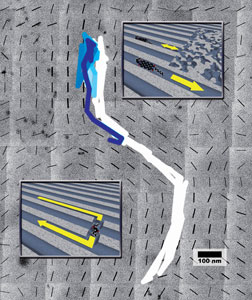博文
sense magnetic fields——Insight into movements could aid catalyst design
|
sense magnetic fields——Insight into movements could aid catalyst design
Chemists in Germany have tracked single molecules diffusing through a porous solid for the first time. The study paves the way for further insights into how catalysts, drug delivery and membrane materials might be improved.
By combining two microscopy techniques, Thomas Bein, Christoph Bräuchle and their teams at the Ludwig-Maximilians University (LMU) in Munich were able to map the fluorescent molecules' trajectories onto the structure of a porous material - giving them unprecedented insight into the influence of structural defects on the molecules' movements.
Bein's team created a 100nm layer of porous silica with fluorescent marker molecules incorporated into the pores. The pores formed a network of channels a few nanometres wide. The team used transmission electron microscopy (TEM) to examine the channels and by stitching together 400 TEM images they were able to build up a picture of the channel network.

|
Trajectories of single dye molecules visualizing the structural details of a mesoporous channel system mapped by transmission electron microscopy. The black bars indicate the local direction of the mesopores
© Zürner et al, Nature |
To follow the molecules as they flowed around the network, Bräuchle's team recorded movies using a wide-field fluorescence microscopy set-up. This technique is so sensitive that individual molecules show up as bright spots. The trajectories from the optical microscope movies were overlayed with the TEM structure by matching up the position of polystyrene marker beads. These markers were added to the silica because they are visible in both microscopy techniques.
Bein didn't know what to expect from the molecules' trajectories: 'There were many surprises because we didn't appreciate the complexity of these processes. Now we can see how rich the local structure of these porous materials is and how diverse the behavior of the molecules is in their pores.'
The channels do not resemble the straight pores seen in a crystal, Bein said. 'Some look like fingerprints, some are fairly straight.'
The molecules followed the channels in straight lines and around curves. But there were blockages where channels of different directions met, and where channels met disordered regions. The teams were able to see molecules performing a u-turn when confronted with these obstacles. Also surprising was the observation of molecules passing laterally from one channel to the next. 'There were basically holes in the channels like a leaky tube,' Bein said.
"There were many surprises because we didn't appreciate the complexity of these processes"
- Thomas Bein
The team are now trying to improve the precision of their measurements. But Bein is confident this type of information could help design catalysts in which molecules do not get stuck at defect sites. '[It can tell us] how the molecules come to an active site, and how they continue to travel afterwards as products,' he told Chemistry World. The technique could also help in the design of hosts for drug delivery and materials for membrane separation, he added.
Sergey Vasenkov studies molecular diffusion at the University of Florida, Gainesville, US. He told Chemistry World molecular trajectories with pore structure is an exciting new way of learning more about diffusion in, and the structure of, porous materials. 'Introduction of this technique opens a possibility to study anomalous diffusion,' which is currently not well understood, Vasenkov added.
Tom Westgate
References
A Zürner et al, Nature, 2007, 450, 705, DOI:10.1038/nature06398
Source: Chemistry world.
https://blog.sciencenet.cn/blog-3913-11994.html
上一篇:酸碱催化奖(田部浩三奖)——The Tanabe Prize for Acid Base Catalysis
下一篇:Between Water And Rock: A New Science

